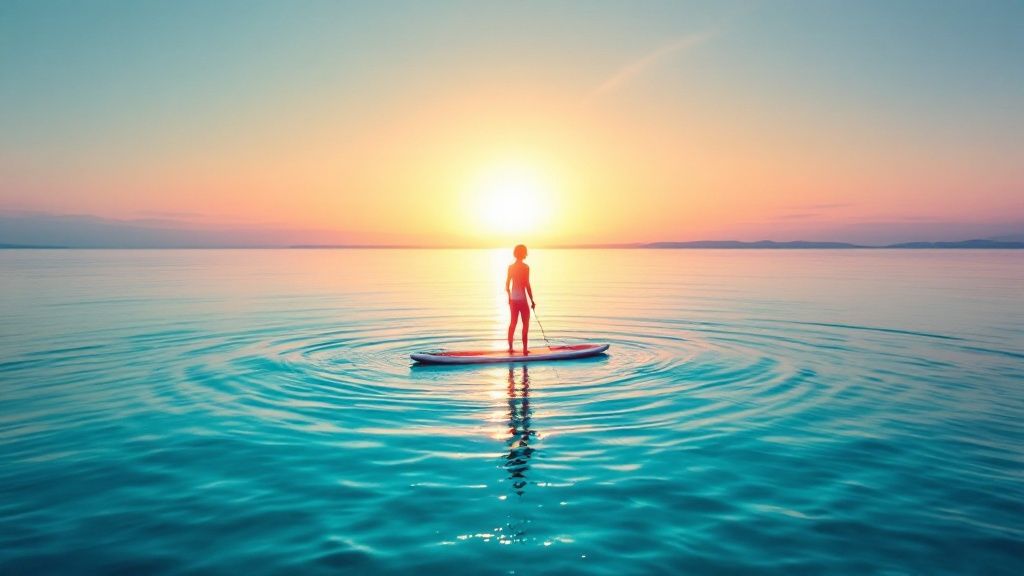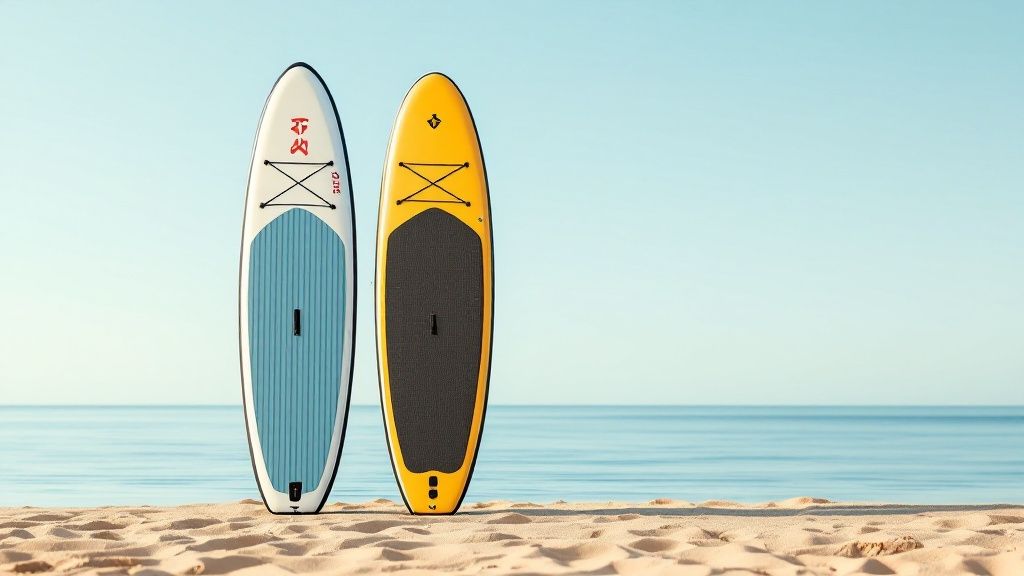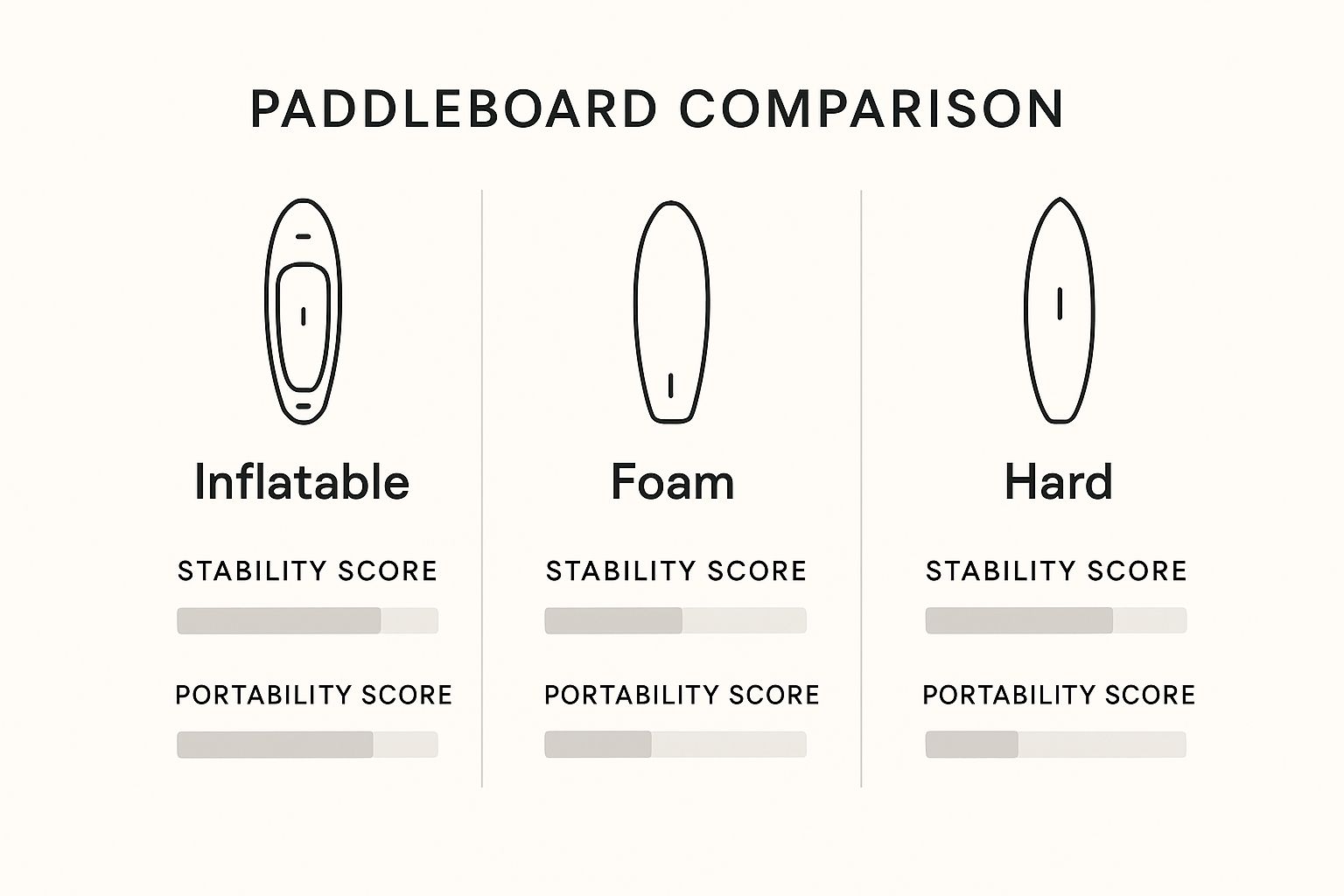Best Paddleboards for Beginners: Your Ultimate Guide

Picking out your very first paddleboard is easily the biggest decision you'll make when getting into the sport. The best paddleboards for beginners are all about stability and forgiveness. They're designed to help you build confidence on the water, which is why inflatable boards have become the go-to choice for their sheer convenience and user-friendly nature. Get this right, and your first few outings will be all about fun, not falling in.
Your Guide to Finding the First Paddleboard
Dipping your toes into the world of stand-up paddleboarding (SUP) is a brilliant feeling, but your board is the one piece of kit that can make or break the experience. Think of it like learning to ride a bike – you wouldn't start on a paper-thin racing bike, would you? You'd want something steady and safe that lets you find your feet and actually enjoy the ride.
For anyone just starting, the two golden rules are stability and ease of use. These two things dictate how quickly you'll feel at home on the water and, frankly, how much fun you'll have. For example, a wobbly, narrow board might tip you in the moment a small boat passes, whereas a stable board will barely register the wake. The right one feels like a solid, floating platform, giving you the confidence to explore from day one.
The Beginner's First Big Decision
Your first major choice comes down to an inflatable SUP (iSUP) versus a traditional hard board. While both have their place, inflatable technology has come on leaps and bounds, making iSUPs the clear winner for most newcomers in the UK. You just can't beat their blend of performance, durability, and convenience. It's also worth thinking about the practical side of things, like where you'll store it and how you'll get it to the water—some people even use a pontoon SUP rack if they're lucky enough to have a boat.
A board like the Loco Amigo Air, for instance, is built from the ground up with beginners in mind. Its generous width gives you a really stable base, making it much easier to stand up and keep your balance, even when the water's a bit choppy. It’s designed to ensure your first day is spent paddling, not swimming.

"Your first paddleboard shouldn't be a challenge; it should be a key that unlocks the water. Prioritise stability above all else, and you'll build skills and confidence much faster."
To help you get your head around the key factors, here's a quick reference guide. It boils down the most important considerations for choosing that perfect first board.
Beginner Paddleboard Quick Decision Guide
| Consideration | Beginner's Best Choice | Why It Matters for Your First Time |
|---|---|---|
| Board Type | Inflatable SUP (iSUP) | Far easier to transport and store. They're also more durable against bumps and knocks. |
| Stability | A wider board (32"+) | More width means more stability. This is the single most important factor for building confidence. |
| Volume | Higher volume | A higher volume board is more buoyant, supporting your weight easily and riding higher in the water. |
| Versatility | All-Round Shape | An "all-round" board is the jack-of-all-trades, perfect for calm lakes, gentle rivers, and even small waves. |
Ultimately, focusing on these simple points will steer you towards a board that makes learning a joy rather than a chore.
A Growing Sport for Everyone
The sheer accessibility of modern beginner boards has caused a massive surge in paddleboarding's popularity across the UK. The sport is growing like crazy, with the market expected to expand at an annual rate of around 20%. This is happening because today's boards have made it incredibly easy for just about anyone to get out on the water and have a go.
A few key things are driving this growth:
- Improved Stability: Advances in design mean beginner boards are wider and more buoyant than ever, making them feel rock-solid underfoot.
- Low-Impact Fitness: It’s a fantastic full-body workout that’s incredibly gentle on your joints.
- Versatility: You can take your board for a peaceful paddle on a lake, a gentle tour down a river, or even try your hand at some SUP yoga.
Boards from brands like Loco Surfing really highlight this progress. They offer high-quality, stable platforms that set you up for success from the get-go, guaranteeing a brilliant start to your SUP adventure.
Decoding Paddleboard Size and Shape

Choosing your first paddleboard can feel a bit like learning a new language. You'll hear terms like volume, width, and length thrown around, and it's easy to get bogged down in the jargon. But trust me, these dimensions aren't just for show; they're the secret ingredients that dictate how a board will feel and perform under your feet.
Getting them right is the single most important step to feeling stable, confident, and having an absolute blast on the water. Think of it this way: a narrow racing kayak is built for speed but will tip you out in a heartbeat, whereas a wide, flat-bottomed punt is incredibly stable but won't be winning any races. Paddleboards follow the exact same principle. As a beginner, your goal isn't speed—it's stability.
Why Width Is Your Best Friend
When you’re looking at paddleboards for beginners, the very first number you should look for is the width. A wider board gives you a much more stable platform, making it a whole lot easier to balance when you're just finding your sea legs. It’s the difference between standing on a wide, sturdy jetty and trying to balance on a narrow beam.
For most newcomers, a board that's 32 inches or wider is the sweet spot. That extra width distributes your weight over a larger area, cutting down on the side-to-side wobble that can send you for an unexpected swim. For example, the Loco Amigo Air, at 34" wide, provides an exceptionally stable platform perfect for building confidence.
Understanding Length and its Impact
While width is all about stability, the board's length affects how it moves through the water. As a rule, longer boards glide straighter and faster, which is great for touring over longer distances. Shorter boards, on the other hand, are much easier to turn and manoeuvre.
A good all-around board for a beginner usually sits in the 10' to 11' range. This length offers a fantastic compromise. It's long enough to track well in a straight line (meaning you're not constantly switching paddling sides), but it's still nimble enough that you can turn without a massive effort. A practical example is the 10'6" Loco Amigo Air, which is ideal for exploring UK lakes, canals, and calm coastal bays.
Board volume is your buoyancy guarantee. It's a simple calculation that ensures your board will float you high and dry, making paddling feel effortless rather than like you're standing on a sinking log.
The Crucial Role of Volume and Thickness
Volume, measured in litres (L), is probably the most critical yet overlooked factor for beginners. It represents the board's ability to displace water, which directly translates to how much weight it can support without becoming unstable. If a board doesn't have enough volume for your weight, it'll sit low in the water, feel sluggish, and be incredibly wobbly.
A simple rule of thumb for beginners is to find a board with a volume in litres that's at least double your weight in kilograms. For example, if you weigh 80kg, you should be looking for a board with a volume of 160L or more.
Thickness also plays a huge part here. Most quality inflatable boards are 6 inches thick, which provides the rigidity and volume needed to support most riders comfortably. This thickness is vital because it stops the board from flexing or "sagging" in the middle, giving you a stable and efficient platform to paddle from. For a more detailed breakdown, you can learn more by checking out our guide on what size paddle board you need.
Our Loco Amigo Air, for instance, was designed with all this in mind. It combines a generous width with the ideal length and volume to create the perfect all-around platform—one that’s incredibly forgiving for beginners but still offers plenty of performance as your skills grow.
Inflatable vs. Hard Boards: What's Right for You?
One of the first big decisions you'll face when buying a paddleboard is choosing between an inflatable (often called an iSUP) and a traditional hard, or solid, board. Think of it like deciding between a high-performance road bike and a versatile mountain bike. Each has its place, and the best one for you hinges on your lifestyle, how much storage space you have, and what you plan to do on the water.
For most people just starting their paddleboarding journey, the choice is actually pretty straightforward. Inflatable technology has come on in leaps and bounds, so modern iSUPs are incredibly rigid and perform brilliantly, but their practical perks are what really seal the deal.
The Rise of the Inflatable Paddleboard
Inflatable paddleboards are the undisputed champions of convenience. They pack down into a large rucksack, making them a doddle to store in a cupboard, chuck in the boot of your car, or even carry on your back to a remote loch. This portability is a total game-changer if you don't have a garage or a van.
Imagine living in a city flat; an iSUP like a Loco Amigo Air is the perfect solution. You don't need a roof rack or a massive storage locker. When you fancy a paddle, you just unroll it, pump it up, and you're on the water in minutes. They’re also fantastically durable. Their tough, military-grade PVC construction means they can take a knock or a bump against rocks far better than a fibreglass board can.
When to Consider a Hard Board
So, if inflatables are that good, why does anyone bother with a hard board? The simple answer is pure performance.
Hard boards, usually made from materials like epoxy and fibreglass, are just that bit more rigid. This means they slice through the water more efficiently, giving you better glide, speed, and responsiveness. If you live near the coast with a garage to stash your gear and you’re dreaming of getting into SUP surfing or racing, a hard board is a brilliant choice. The subtle shaping that’s possible with a hard board gives it a performance edge that more serious paddlers really notice.
The downside? They’re heavier, much more prone to dings and scratches, and you need a fair bit of space to store one.
This image gives you a quick visual breakdown of how different board types compare on portability and stability.

As you can see, inflatable boards nail that sweet spot of ultimate portability without sacrificing much stability, making them a fantastic starting point for most newcomers.
"For 95% of beginners, an inflatable SUP is the smarter choice. It removes the barriers of storage and transport, letting you focus on what really matters—getting out on the water and having fun."
To help you weigh it all up, here’s a simple comparison table.
Inflatable vs. Hard Paddleboard Comparison for Beginners
| Feature | Inflatable Paddleboard (e.g., Loco iSUP) | Hard Paddleboard |
|---|---|---|
| Portability | Excellent. Folds into a backpack. | Poor. Requires roof rack and large storage space. |
| Storage | Very easy. Fits in a cupboard or car boot. | Difficult. Needs a garage or dedicated large space. |
| Durability | Very high. Resists drops and impacts well. | Moderate. Prone to dings, scratches, and cracks. |
| Performance | Good to excellent. Great glide for all-round use. | Excellent. Superior speed, glide, and responsiveness. |
| Stability | Generally very stable, especially wider models. | Varies by shape; can be less forgiving. |
| Best For | Beginners, all-round paddling, travel, limited storage. | SUP surfing, racing, performance-focused paddlers. |
Ultimately, the decision boils down to a trade-off: unmatched convenience versus peak performance. For most beginners, the convenience of an inflatable wins out every time, letting you get on the water more often and with less fuss.
If you want to dive even deeper into the details, check out our comprehensive inflatable paddle board buyer's guide to make sure you find the perfect board for your adventures.
Essential Gear For Your First Paddle
So, you’ve picked out your perfect first board. It’s a great feeling, but it’s tempting to think that’s all you need before hitting the water. The truth is, your board is just the start of the adventure.
Having the right gear doesn't just make your time paddling safer and more comfortable—it makes it way more enjoyable. Think of it like packing for a hike; you wouldn't head out for the day without decent shoes and some water. Paddleboarding is no different.
A few bits of kit are non-negotiable for your safety, while others just make life easier. Nailing this from the get-go will set you up for countless stress-free and successful sessions out on the water.
The Non-Negotiable Kit
There are three items that every single paddler needs, whether you're taking your first wobbly steps or you're a seasoned pro. These aren't optional extras; they're your fundamental safety gear.
-
Your Paddle: This is your engine. Simple as that. An incorrectly sized paddle will strain your back and shoulders, turning a fun session into a real chore. For instance, using a paddle that is too long will make your shoulders ache, while one that's too short forces you to hunch over. A good rule of thumb is that the handle should reach your wrist when you stand the paddle upright and raise your arm straight above your head.
-
A Leash: Think of this as your lifeline. The leash tethers you to your board, which is essentially a massive flotation device. If you fall off—and you will—your board can get swept away by wind or current faster than you can swim. A leash guarantees it’s always within arm's reach.
-
A Personal Flotation Device (PFD): In the UK, it’s highly recommended to wear a PFD. This is usually a buoyancy aid, which is designed to keep you afloat if you get into trouble but is streamlined enough that it won't get in the way of your paddling.
A coiled leash is almost always the best bet for beginners paddling on flat water. Unlike a straight surf leash, it stays up on the board instead of dragging in the water, which stops it from getting snagged on weeds, branches, or anything else lurking under the surface.
Highly Recommended Extras
Beyond the absolute must-haves, a few other items can make a huge difference to your day, especially given the famously unpredictable UK weather. It’s a good idea to pack these for your first few outings.
-
Dry Bag: A small dry bag is an absolute godsend for keeping your phone, car keys, and a snack safe and dry. They’re cheap and give you brilliant peace of mind while you're out exploring.
-
Appropriate Clothing: Whatever you do, avoid cotton. It gets wet, stays wet, and makes you cold. Go for quick-drying sportswear or, if it's a cooler day, a wetsuit. Layering is your friend here, as you can adjust as you warm up or as the weather changes. For example, a thermal rash vest under a windproof jacket works well on a chilly but sunny day.
-
Hydration: Paddling is a proper workout, and it's easy to get dehydrated. It's not just about the board; looking after yourself is key. You can find practical advice on what to drink during exercise from health resources like the NHS Eatwell Guide.
Investing in quality accessories from the start is always a smart move. Essentials like a durable Loco leash and a comfortable PFD are built to last trip after trip, meaning you can keep your focus where it should be: on having fun.
Your First Day on the Water: A Step-by-Step Guide

With your board and gear ready, the real adventure begins. That first session is all about taking things slowly, building up your confidence, and just getting a feel for how the board moves underneath you. A successful first outing isn't about paddling for miles; it's about finishing with a smile on your face, already buzzing for your next trip.
We'll walk you through the key steps, from getting your board to the water's edge to that triumphant moment you stand up for the first time. The goal is to make it all feel natural and intuitive, turning any initial wobbles into steady, confident paddling.
Getting Started On Land
Before you even dip a toe in the water, a little prep on the shore goes a long way. Find a calm, sheltered spot to launch from—a gentle sandy beach or a low-floating pontoon is perfect. Steer clear of areas with strong currents, lots of boat traffic, or a strong offshore wind that could push you out from the shore.
First things first, you need to get your board to the water. Most paddleboards for beginners, especially inflatables like the Loco Amigo Air, have a handle right in the centre. Just tuck the board under one arm with the handle facing out and carry it to the water’s edge. Keep the fins pointing up so you don’t drag them. Simple.
Launching and Finding Your Balance
Once you're at the water, walk your board out until the fin is completely clear of the bottom. This is usually when the water is about knee-deep. Now, place your paddle horizontally across the deck of the board in front of you, where you can easily grab it.
It's time to get on.
- Start on Your Knees: Place one knee on the centreline of the board, just behind the carry handle. Follow with your other knee, keeping them about shoulder-width apart. This gives you a really stable, four-point base to start from.
- Stay Low and Centred: Keep your hands on the board for extra support as you get used to that gentle rocking motion. You should feel like your weight is spread evenly.
- Grab Your Paddle: Once you feel steady, pick up your paddle. Try taking a few gentle strokes from this kneeling position. It’s a brilliant way to get a feel for how the paddle moves you through the water without worrying about balance.
The most common beginner mistake is staring down at your feet. Your body naturally follows where your eyes go, so looking down is a surefire way to feel unsteady. Instead, fix your gaze on the horizon—this one simple trick will dramatically improve your balance.
Standing Up for the First Time
After a few minutes of paddling on your knees, you’ll start to feel more at home on the board. Now you’re ready for the main event: standing up. The secret here is to make it one smooth, deliberate movement, not a jerky jump.
- Position Your Hands: Place your hands on the board in front of your knees, about shoulder-width apart, like you’re setting up for a press-up.
- Bring One Foot Forward: Slide one foot forward to where your knee was, planting it flat on the board.
- Follow with the Other Foot: Quickly but smoothly, bring your other foot forward so your feet are parallel and roughly shoulder-width apart, straddling that centreline.
- Rise Up Slowly: Keep your knees bent and your back straight, and slowly raise your chest until you’re standing. Grab your paddle, and you’re off!
Mastering the Basic Strokes
Once you're up, you really only need three basic strokes to get yourself moving and steering.
- Forward Stroke: This is your engine. Reach forward, plant the paddle blade fully into the water, and pull it back towards your feet. Remember to keep your top arm straight and use your core muscles to power the stroke—it's not all about the arms!
- Sweep Stroke: Need to turn? Just perform a wide, arching forward stroke away from the board, like you’re sweeping the water in a big semi-circle from the nose to the tail. This will gracefully turn the nose of your board.
- Reverse Stroke: This is your brake pedal. Place the paddle in the water behind you and push it forward, towards the nose. This will slow you right down and can also be used to turn the board in the opposite direction.
By practising these simple steps, your first day on one of the best paddleboards for beginners is guaranteed to be a huge success. The main thing is to take it easy, stay relaxed, and focus on having fun. You'll be paddling like a pro in no time. For even more pointers, check out this excellent guide on how to paddle board for beginners.
Still Got Questions? We've Got Answers
Even after soaking up all that info, it's totally normal to have a few last questions buzzing around before you pull the trigger on your first board. We get it. This section cuts straight to the chase, tackling the most common queries we hear from paddlers just starting out, so you can feel 100% confident when you finally hit the water.
What Size Paddleboard Do I Need as a Beginner?
As a beginner, your best friend is stability. That’s why you should always look for a board that’s at least 32 inches wide. A wider platform gives you a much steadier base to learn on, making those first few wobbles far less intimidating.
To make sure the board has enough buoyancy to support you properly, check its volume, which is measured in litres (L). A good rule of thumb is to find a board with a volume that's roughly double your weight in kilograms. So, if you weigh 80kg, you’ll want a board with at least 160L of volume. All-around boards, like our Loco Amigo Air, which typically sit between 10' and 11' long, are the perfect starting point. They strike a brilliant balance between stability and manoeuvrability for exploring UK waters.
Is Paddleboarding Difficult to Learn?
Honestly? Not at all! Paddleboarding is one of the most welcoming and rewarding water sports you can pick up. Most beginners are standing up and paddling within their first hour on calm water, especially when they're on a stable, beginner-friendly board.
The real secret is to start on your knees. This lowers your centre of gravity and helps you get a feel for how the board moves before you even think about standing. For more hands-on tips, check out this great step-by-step guide to paddling for beginners. A quick lesson with a local school can also work wonders for your confidence.
How Do I Take Care of My New Paddleboard?
A little bit of love goes a long way in making sure your board is ready for years of adventures. It’s simpler than you think:
- Rinse After Use: Always give it a quick wash-down with fresh water to get rid of any salt, sand, or grime.
- Avoid Direct Sunlight: Don't leave your board baking in the sun. UV rays can damage the materials over time, so find a shady spot for storage.
- Store Correctly: For an inflatable, it's best to store it loosely rolled or even partially inflated if you have the space. If you've got a hard board, a padded bag is a smart investment to protect it from knocks and dings.
"A well-maintained board isn't just about longevity; it's about performance and safety. A quick rinse and proper storage take minutes but add years to your board's life."
Here at Loco Surfing, we're all about helping you start your paddleboarding journey with the right gear and solid advice. Take a look at our full range of beginner-friendly paddleboards and find the perfect ride to unlock your adventures on the water.




